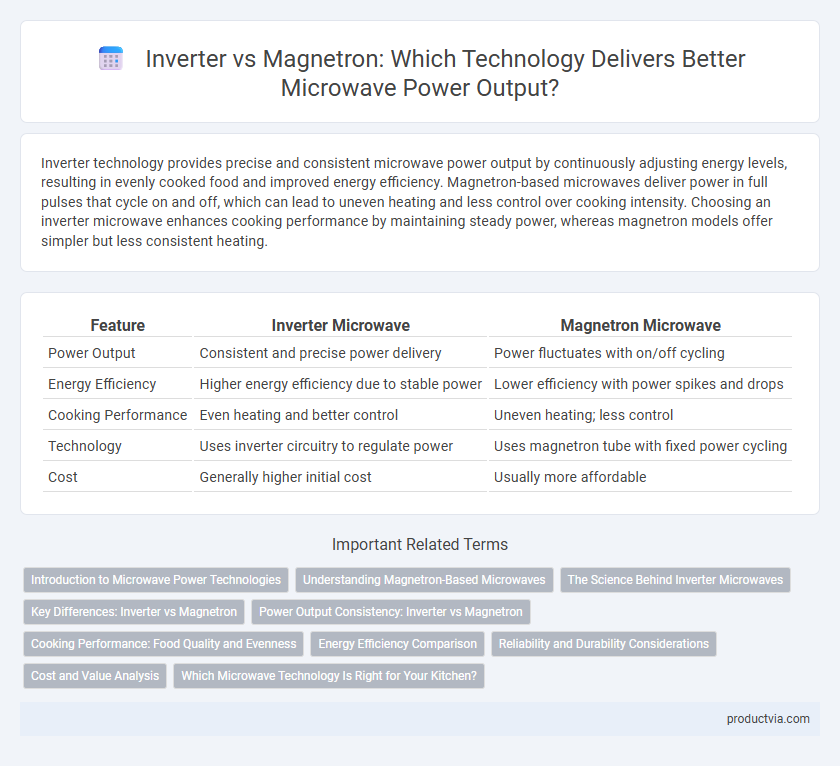Inverter technology provides precise and consistent microwave power output by continuously adjusting energy levels, resulting in evenly cooked food and improved energy efficiency. Magnetron-based microwaves deliver power in full pulses that cycle on and off, which can lead to uneven heating and less control over cooking intensity. Choosing an inverter microwave enhances cooking performance by maintaining steady power, whereas magnetron models offer simpler but less consistent heating.
Table of Comparison
| Feature | Inverter Microwave | Magnetron Microwave |
|---|---|---|
| Power Output | Consistent and precise power delivery | Power fluctuates with on/off cycling |
| Energy Efficiency | Higher energy efficiency due to stable power | Lower efficiency with power spikes and drops |
| Cooking Performance | Even heating and better control | Uneven heating; less control |
| Technology | Uses inverter circuitry to regulate power | Uses magnetron tube with fixed power cycling |
| Cost | Generally higher initial cost | Usually more affordable |
Introduction to Microwave Power Technologies
Inverter microwave technology utilizes a semiconductor inverter to provide continuous, precise power levels, enabling more consistent cooking results and energy efficiency compared to traditional magnetron systems, which operate by cycling the magnetron on and off at full power. The magnetron, a vacuum tube generating microwave radiation, produces power in a fixed output pattern, causing fluctuations in cooking intensity and less uniform heating. Understanding these distinct power delivery methods is crucial for selecting microwave ovens that balance performance, energy consumption, and cooking precision.
Understanding Magnetron-Based Microwaves
Magnetron-based microwaves generate power through a vacuum tube that produces high-frequency electromagnetic waves, offering a consistent but fixed power output during operation. These microwaves typically cycle on and off at full power to achieve the desired cooking level, which can lead to uneven heating and hot spots in food. Understanding magnetron technology highlights its durability and cost-effectiveness, making it a common choice despite less precise power control compared to inverter-based models.
The Science Behind Inverter Microwaves
Inverter microwaves utilize advanced semiconductor technology to deliver a consistent and precise power output by regulating electrical current flow, unlike traditional magnetron models that rely on simple on/off pulses. This continuous power control allows for more even cooking and defrosting, avoiding hot and cold spots typical in magnetron microwave ovens. The inverter technology enhances energy efficiency and improves temperature accuracy, resulting in superior food texture and nutrient preservation.
Key Differences: Inverter vs Magnetron
Inverter microwaves provide consistent and precise power output by continuously regulating voltage, resulting in more even cooking and energy efficiency. Magnetron microwaves operate by cycling power on and off at full wattage, leading to uneven heating and less control over cooking intensity. The key difference lies in the power delivery method: inverter technology enables variable power levels, whereas magnetron technology relies on simple on/off power bursts.
Power Output Consistency: Inverter vs Magnetron
Inverter microwaves deliver consistent power output by continuously adjusting the energy level, allowing precise cooking and defrosting at lower power settings without temperature fluctuations. Magnetron microwaves operate at full power and cycle on and off to achieve lower power levels, resulting in uneven heating and inconsistent cooking performance. The inverter technology's ability to provide a steady, reliable power output improves food texture and reduces overcooking compared to traditional magnetron systems.
Cooking Performance: Food Quality and Evenness
Inverter microwaves provide consistent and adjustable power levels, resulting in more evenly cooked food and better retention of texture and moisture compared to traditional magnetron models, which operate at full power or off, causing uneven heating. This precise power modulation enhances cooking performance by preventing overcooking edges and undercooked centers, especially in delicate dishes. Magnetron microwaves may produce hotspots and less uniform results, impacting overall food quality during reheating or defrosting.
Energy Efficiency Comparison
Inverter microwave technology provides more precise power control by regulating electrical current, resulting in consistent energy output and improved cooking efficiency compared to traditional magnetron models that operate at fixed power cycles. This modulation reduces energy waste and lowers electricity consumption, making inverter microwaves significantly more energy-efficient for everyday cooking tasks. Magnetron microwaves often consume higher peak power and experience fluctuating energy use, leading to less efficient performance overall.
Reliability and Durability Considerations
Inverter microwaves offer more consistent power output by modulating energy, enhancing reliability and reducing wear on components compared to traditional magnetron models. Magnetrons, while typically more affordable, operate at full power during cooking cycles, which can lead to quicker degradation and less precise temperature control. For long-term durability, inverter technology tends to extend the lifespan of the microwave by preventing overheating and minimizing mechanical stress.
Cost and Value Analysis
Inverter microwaves offer precise power control and energy efficiency but typically come at a higher upfront cost compared to traditional magnetron models, which are generally more affordable and reliable for basic heating tasks. While magnetron technology delivers consistent power output suitable for standard cooking, inverter technology enhances cooking quality by providing variable power levels, resulting in better food texture and energy savings over time. Choosing between inverter and magnetron microwaves depends on balancing initial investment with long-term value, where inverter models excel in efficiency and cooking performance, justifying their higher price for frequent users.
Which Microwave Technology Is Right for Your Kitchen?
Inverter microwaves provide consistent, precise power output by continuously adjusting energy levels, resulting in evenly cooked food and better energy efficiency. Magnetron microwaves operate with a fixed power cycle, causing uneven heating and potential overcooking or undercooking in certain areas. For kitchens prioritizing precise cooking and energy savings, inverter technology offers superior performance over traditional magnetron models.
Inverter vs Magnetron for microwave power output Infographic

 productvia.com
productvia.com